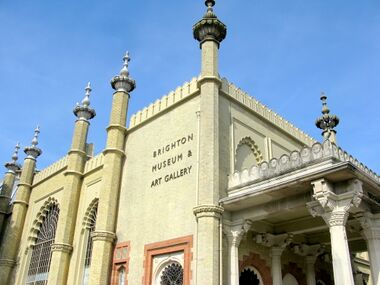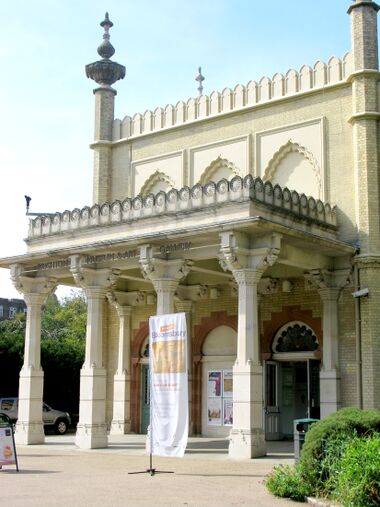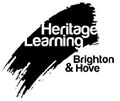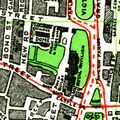Category:Brighton Museum and Art Gallery
Brighton Museum and Art Gallery, with side-wall text [image info]
Brighton Museum and Art Gallery, "Bloomsbury " exhibition banner, 2011 [image info]
Brighton Museum and Art Gallery is a civic museum built into an extension of the Brighton Dome/Brighton Corn exchange buildings, part of the Brighton Pavilion complex.
The museum introduced admission charges for non-residents in May 2015 in an attempt to cut costs. The main body of the museum is free to local residents, with the exception of special temporary exhibitions on the first floor, which usually carry an admission charge.
In 2016, the museum replaced part of the entrance lobby shop space with a coffee shop.
Origins
The Royal Pavilion and Brighton Dome complex has hosted museum and gallery displays almost since its original acquisition for the town by the Commissioners in 1850, with displays being held in the Great Kitchen from the early 1850s, and a museum of sorts being set on on the first floor in around 1859.
With the upper-floor display space awkward to navigate and less than ideal for large exhibits, the town decided to create a dedicated museum and gallery space on the site, by building an extension to the Stables complex. This part of the Pavilion complex site had originally been open space, divided off from Church Street by a wall, and used for miscellaneous purposes such as exercising horses.
1870s – A dedicated Museum and Art Gallery
Plans for turning the area into tennis court(s) never came to fruition, and the site was transformed by Philip Lockwood into a natural extension of the existing Dome and Corn Exchange frontage, with the entrance to the new Museum and Art Gallery on Church Street, with a small entrance lobby opening onto a bright picture gallery. The new museum building got excited reviews in 1872, and appears to have first properly opened to the public some time around 1871-73.
By 1876, this new use of the buildings was well established, to the extent that questions were raised as to whether the funding of the ongoing displays via local rates were strictly covered by the 1850 Act (which had allowed for the use of the site for educational and scientific purposes, but hadn't dealt with the idea of a permanent museum or gallery). The subsequent 1876 Act explicitly legitimised the funding of the Museum and Art Gallery, and also relaxed the restriction of paid use for the rest of the building, so that ticketed concerts and events could be held in the recently refurbished Dome.
1876 Act (excerpt)
...
And whereas the Corporation have, at their own expense, adapted part of the Pavilion Estates for, and have therein established a free library, museum, and picture gallery, the expense of maintaining which has been defrayed by the Corporation out of the rates levied by them under the Acts of 1850 and 1867, but doubts have arisen whether the establishment and maintenance of the said library, museum and picture gallery are purposes for which such rates are legally applicable, and it is expedient that such doubts be removed:
...
1902 – rebuild
The building's use further increased with the opening of a Lending Library in 1889, and with the vacation of part of the building by other council officials it was decided to remodel and expand the space, with the new Borough Surveyor F.J.C. May 5th redesigning the interiors with Eastern motifs and geometrical tiling reminiscent of mosque decoration.
1933 description:
The Public Library, Museum, and Fine Art Galleries
Open.–Lending Library, 10 a.m. to 8 p.m. Reference Library, 10 a.m. to 9 p.m. News and Magazine Rooms, 9 a.m. to 9 p.m.
The Museum and Art Galleries are open on weekdays from 10 a.m., the hour of closing varying with the season. Open on Sundays 2.30-5 p.m. A special Guide to the institution is on sale.This institution is in Church Street, adjoining the Dome, and the style is in keeping with the Pavilion. Originally erected in 1873, the buildings were reopened in 1902, after reconstruction and extension, at a cost of £50,000.
- The Library comprises reference and lending departments, newspaper and magazine rooms. The Reference Department is available to all readers, without introduction or guarantee, and contains over 65,000 volumes, including several special collections, comprising theology, classics, Italian works, natural history, atlases, directories, dictionaries, encyclopaedias, and Oriental languages. There is also a valuable collection of works relating to the history and topography of the town and county.
- The Lending Department, known as the Victoria Lending Library, in commemoration of Queen Victoria's Jubilee, contains about 55,000 volumes, and the latest and best books are constantly added. Ratepayers can use it on their own guarantee; non-ratepayers (whether inhabitants or visitors) are entitled to borrow on obtaining a voucher signed by a ratepayer.
- The Art Galleries contain many pictures in oils and water-colours belonging to the town, including the Willett Collection; and important loan exhibitions are held from time to time. For some years the Committee have arranged for the exhibition of the work of modern Continental artists. A beginning was made in 1910 with the French School, then followed Swedish, Danish, Norwegian, Spanish, Belgian, Russian, Japanese and Dutch Exhibitions. In 1923 a second Exhibition of modern French Art was displayed; at the 1925 Exhibition modern Italian Art. The series is to be continued.
- A recent acquisition, of which Brighton is proud, is the Henry George Simpkins Bequest of pictures, displayed in a room adjoining the Exhibition Galleries.
- The Museum comprises features to be found in no other institution of the kind. Among rarities to which special attention may be called is an amber cup, found in a British barrow at West Brighton. For some time it was believed to be the only one of its kind, but a second has been found in Dorset. The collection of chalk fossils is one of the finest in Europe, as one would expect considering the locality. The conchological specimens are also very fine; but perhaps the most interesting feature of the Museum is the Willett Collection of English Pottery (on the ground floor), for many years loaned to the town, but now, thanks to the generosity of the collector, the property of the municipality (catalogues 2d.). Every visitor to Brighton with half an hour to spare should make a point of seeing this fine collection, which comprises 2,000 pieces and is, by desire of Mr. Willett, arranged in subject, not ceramic, order. The idea is "to illustrate the principle that the history of a country may be traced in its homely pottery." Mugs, saucers, jugs, plates, etc., are all brought into requisition, and illustrate most admirably the costumes, sports, and popular opinions prevalent at the time of their manufacture. Mr. Willett was one of the most munificent of Brighton's citizens, and the friend of Ruskin and Oliver Wendell Holmes. He died in 1905 at the age of eighty-three, and added to his other benefactions by bequeathing to the Museum his splendid collection of objects of ethnological and antiquarian interest.
Elsewhere are Zoological and other- collections, including one illustrating "Old Sussex."
— , -, , A Pictorial and Descriptive Guide to Brighton and Hove, 10th Edition, , Ward, Locke & Co Ltd., , 1933
Twenty-First Century
Brighton got a far bigger central library with the opening of the Jubilee Library in 2005, and the old library space above the museum became Brighton History Centre, archiving research material related to the history of Brighton.
With the planned opening of The Keep, the History Centre in turn became redundant, and closed from 1st April 2013 for the transfer of its holdings to The Keep, which opened its doors in November 2013.
The History Centre space was repurposed again in Spring 2015, becoming the Museum and Art Gallery's Museum Lab, a multi-purpose space typically split into a cordoned-off curatorial office space and restoration space, and a general-purpose space for supervised "hands-on" public activities.
External links
Subcategories
This category has only the following subcategory.
P
Pages in category ‘Brighton Museum and Art Gallery’
This category contains only the following page.
Media in category ‘Brighton Museum and Art Gallery’
The following 6 files are in this category, out of 6 total.
- Brighton Museum and Art Gallery, 2011.jpg 1,650 × 2,200; 1.37 MB
- Brighton Museum and Art Gallery, corner view, 2011.jpg 2,200 × 1,650; 1.38 MB
- Furniture by Charles Rennie Mackintosh for WJ Bassett-Lowke.jpg 1,024 × 683; 306 KB
- Furry Snowdog at Brighton Museum and Art Gallery (2016-10).jpg 2,400 × 1,600; 2.72 MB
- Heritage Learning Brighton and Hove.jpg 142 × 120; 9 KB
- Pavilion Estate, 1939 map (BrightonHbk 1939).jpg 1,371 × 1,372; 929 KB










